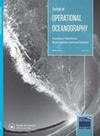Sea surface temperature effects on the modelled track and intensity of tropical cyclone Gonu
IF 2.4
3区 地球科学
Q4 METEOROLOGY & ATMOSPHERIC SCIENCES
引用次数: 1
Abstract
ABSTRACT The seven simulations were performed to investigate the role of the sea surface temperature (SST) in numerical prediction of tropical cyclones (TCs). The TC Gonu, formed over the Arabian Sea in 2007, was selected for this study. The first five simulations were performed using WRF model. In the first simulation as control simulation (CTL), the SST derived from NCEP-MMAB was used. In the second simulation, 1°C was added to input SST, and in the third simulation, 1°C was subtracted to input SST. It was found that the deviation between the simulated track of simulation SST +1 and CTL is more significant than that between simulation SST −1 and CTL. For the fourth simulation, a homogeneous SST field over the entire basin was used. For the fifth simulation, SST anomaly was calculated, and its values were added to the entire domain. Removing the temperature gradient caused TC intensity to decrease and deviation of the track to the northeast; the increasing temperature gradient had a lower impact on the TC intensity but with a significant deviation of the track to the north with respect to the CTL simulation. In the sixth simulation to consider cyclone-induced SST cooling, a one-dimensional oceanic mixed layer scheme was applied. Results showed no significant reduction in TC intensity. In the seventh simulation, the COAWST modelling system was used. The simulated SST of the COAWST model was consistent with the satellite observations, which finally led to improve the simulation of track and intensity of TC Gonu.海表温度对热带气旋戈奴模拟路径和强度的影响
摘要通过7次模拟,探讨了海表温度(SST)在热带气旋数值预报中的作用。2007年在阿拉伯海形成的TC Gonu被选为这项研究的对象。前5次模拟采用WRF模型进行。在第一次模拟作为对照模拟(CTL)中,使用了NCEP-MMAB衍生的SST。在第二次模拟中,输入海温增加1°C,在第三次模拟中,输入海温减去1°C。结果表明,模拟SST +1与CTL的模拟轨迹偏差大于模拟SST−1与CTL的模拟轨迹偏差。第四次模拟采用整个盆地的均匀海温场。第五次模拟计算了海表温度异常,并将海表温度异常值加到整个区域。消除温度梯度使TC强度减小,轨道偏东北;升高的温度梯度对TC强度的影响较小,但与CTL模拟相比,路径向北偏移明显。第六次模拟考虑气旋引起的海温冷却,采用一维海洋混合层格式。结果显示,TC强度无明显降低。在第七次仿真中,使用COAWST建模系统。COAWST模式模拟的海表温度与卫星观测值基本一致,从而改善了对古奴热带气旋路径和强度的模拟。
本文章由计算机程序翻译,如有差异,请以英文原文为准。
求助全文
约1分钟内获得全文
求助全文
来源期刊
CiteScore
7.50
自引率
9.70%
发文量
8
审稿时长
>12 weeks
期刊介绍:
The Journal of Operational Oceanography will publish papers which examine the role of oceanography in contributing to the fields of: Numerical Weather Prediction; Development of Climatologies; Implications of Ocean Change; Ocean and Climate Forecasting; Ocean Observing Technologies; Eutrophication; Climate Assessment; Shoreline Change; Marine and Sea State Prediction; Model Development and Validation; Coastal Flooding; Reducing Public Health Risks; Short-Range Ocean Forecasting; Forces on Structures; Ocean Policy; Protecting and Restoring Ecosystem health; Controlling and Mitigating Natural Hazards; Safe and Efficient Marine Operations

 求助内容:
求助内容: 应助结果提醒方式:
应助结果提醒方式:


